
Tiziano Vecellio, Latinized as Titianus, hence known in English as Titian, was an Italian Renaissance painter, the most important artist of Renaissance Venetian painting. He was born in Pieve di Cadore, near Belluno. During his lifetime he was often called da Cadore, 'from Cadore', taken from his native region.

Paolo Caliari, known as Paolo Veronese, was an Italian Renaissance painter based in Venice, known for extremely large history paintings of religion and mythology, such as The Wedding at Cana (1563) and The Feast in the House of Levi (1573). Included with Titian, a generation older, and Tintoretto, a decade senior, Veronese is one of the "great trio that dominated Venetian painting of the cinquecento" and the Late Renaissance in the 16th century. Known as a supreme colorist, and after an early period with Mannerism, Paolo Veronese developed a naturalist style of painting, influenced by Titian.

Lorenzo Lotto was an Italian Renaissance painter, draughtsman, and illustrator, traditionally placed in the Venetian school, though much of his career was spent in other north Italian cities. He painted mainly altarpieces, religious subjects and portraits. He was active during the High Renaissance and the first half of the Mannerist period, but his work maintained a generally similar High Renaissance style throughout his career, although his nervous and eccentric posings and distortions represented a transitional stage to the Florentine and Roman Mannerists.
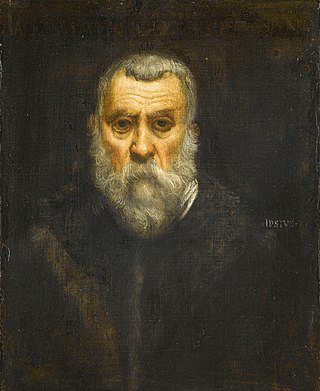
Jacopo Robusti, best known as Tintoretto, was an Italian Renaissance painter of the Venetian school. His contemporaries both admired and criticized the speed with which he painted, and the unprecedented boldness of his brushwork. For his phenomenal energy in painting he was termed il Furioso. His work is characterised by his muscular figures, dramatic gestures and bold use of perspective, in the Mannerist style.
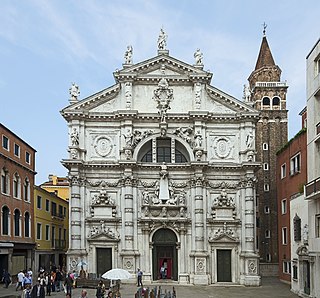
The Chiesa di San Moisè is a Baroque style, Roman Catholic church in Venice, northern Italy.

Juan de Flandes was a Flemish painter active in Spain from 1496 to 1519. His actual name is unknown, although an inscription Juan Astrat on the back of one work suggests a name such as "Jan van der Straat". Jan Sallaert, who became a master in Ghent in 1480, has also been suggested. He worked in the Early Netherlandish style.

Carlo Ridolfi (1594–1658) was an Italian art biographer and painter of the Baroque period.

San Giorgio Maggiore is a 16th-century Benedictine church on the island of the same name in Venice, northern Italy, designed by Andrea Palladio, and built between 1566 and 1610. The church is a basilica in the classical Renaissance style and its brilliant white marble gleams above the blue water of the lagoon opposite the Piazzetta di San Marco and forms the focal point of the view from every part of the Riva degli Schiavoni.

Leandro Bassano, also called Leandro dal Ponte, was an Italian artist from Bassano del Grappa who was awarded a knighthood by the Doge of Venice. He was the younger brother of artist Francesco Bassano the Younger and third son of artist Jacopo Bassano. Their father took his surname from their town of Bassano del Grappa, and trained his sons as painters.

The Feast in the House of Levi or Christ in the House of Levi is a 1573 oil painting by Italian painter Paolo Veronese and one of the largest canvases of the 16th century, measuring 555 cm × 1,309 cm. It is now in the Gallerie dell'Accademia, in Venice. It was painted by Veronese for a wall of a Dominican friary called the refectory of the Basilica di Santi Giovanni e Paolo.
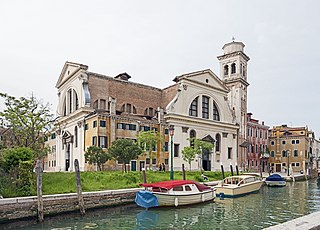
San Trovaso is a church in the sestiere or neighborhood of Dorsoduro in Venice, northern Italy.

The Last Supper is a painting by the Italian Renaissance artist Jacopo Tintoretto. An oil painting on canvas executed in 1592–1594, it is housed in the Basilica di San Giorgio Maggiore in Venice, Italy.

The Stonemason's Yard is an early oil painting by Giovanni Antonio Canal, better known as Canaletto. It depicts an informal scene in Venice, looking over a temporary stonemason's yard in the Campo San Vidal set up for the construction of Andrea Tirali's facade of the church of San Vidal, and across the Grand Canal towards the church of Santa Maria della Carità. Painted in the mid to late 1720s, it is now in the collection of the National Gallery in London and is considered one of Canaletto's finest works.
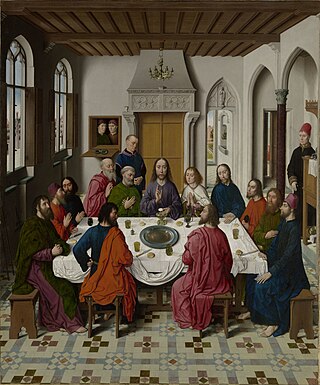
The Last Supper of Jesus and the Twelve Apostles has been a popular subject in Christian art, often as part of a cycle showing the Life of Christ. Depictions of the Last Supper in Christian art date back to early Christianity and can be seen in the Catacombs of Rome.

Christ Driving the Money Changers from the Temple also referred to as The Cleansing of the Temple and The Purification of the Temple is a 1595-1600 Christian art painting by El Greco, now on exhibit in the Frick Collection in New York City. It depicts the Cleansing of the Temple, an event in the Life of Christ. This version of Christ Driving the Money Changers from the Temple was painted approximately four years before his death in 1614. It is thought to be one of his last major works during his many prolific years in Toledo, Spain. This theme consumed El Greco during his career as evidenced by the numerous versions of the painting still on display throughout the world.

The church of San Marcuola is a religious building facing the Grand Canal and located in the sestiere of Cannaregio in Venice, Italy. It is dedicated to the saints Hermagoras and Fortunatus. Palazzo Memmo Martinengo Mandelli is a neighboring building.

Henry Woods was a British painter and illustrator, and one of the leading Neo-Venetian school artists.

Wedding at Cana also known as Wedding Feast at Cana and Le Nozze di Cana is an oil painting by Michael Damaskinos. He was active during the second half of the 16th century in Heraklion, Sicily, Venice, and different parts of Italy. Over 100 works are attributed to the artist. Most of his work resembled the Greek mannerisms prevalent at the time also known as maniera greca. He was clearly influenced by Venetian painting. His version of the Wedding at Cana was a copy of Tintoretto's massive painting of the Wedding Feast at Cana. The monumental canvas was 4.4 m x 5.9 m or 14.4 ft x 19.3 ft. The painting was originally in the dining hall (refectory) of the convent of the Crociferi in Venice. Refectories typically featured large paintings of biblical banquet scenes. The monks preferred biblical banquet scenes because they desired the impression of dining with Christ. Damaskinos probably saw the painting at the convent or a copy of the masterpiece in Venice. The Damaskinos version is much smaller than the original. The painting is very important because it is one of the few instances where Damaskinos broke from the traditional maniera greca prevalent in most of his works. In this instance, he strictly followed the lines of Venetian painting exhibiting his superior craftsmanship as a painter capable of changing his style. El Greco was another painter who also painted in both styles. The Damaskinos version is currently at the Museo Correr in Venice, Italy.
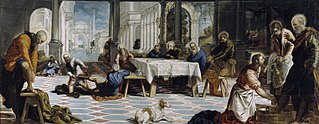
The Washing of the Feet or El Lavatorio is a work by the Venetian artist Tintoretto which he produced between 1548 and 1549. It is considered one of his finest works. It is currently on display in the Museo del Prado.

























